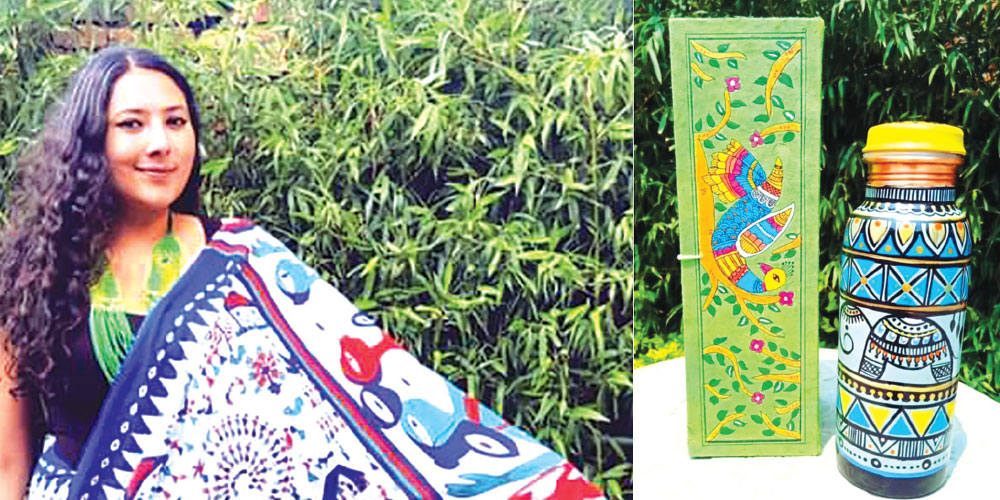- Saturday, 30 August 2025
Trishna's Innovative Fusion Of Mithila Art In Products
In the heart of Lalitpur, Trishna Singh Bhandari is leading a cultural revival that celebrates Madhesi heritage and art. Balancing her role as Private Sector Engagement Manager at Swisscontact Nepal with her passion for cultural preservation, Trishna holds a Master’s Degree in International Environment Law and Policy from Macquarie University, Australia. Her journey has taken a unique turn with the founding of Mithila House, a social enterprise dedicated to preserving Mithila art.
Mithila House offers a wide range of hand-painted products, from clothing and accessories to home décor, blending traditional Mithila art with modern themes, which pleases both art lovers and the general public. More than a brand, it empowers Madhesi women while promoting the rich legacy of Mithila culture, reaching audiences across Nepal and beyond. She’s championing a cultural renaissance. Trishna envisions bridging the cultural divide between the Madhes, hills, and mountains while ensuring the survival of this centuries-old art form and uplifting the indigenous women of the Madhesi community.
Mithila house
Born and raised in Aurahi, Mahottari, a district rooted in the traditions of the Madhesi culture, Trishna realised many of her friends from the hills, especially Kathmandu, were unaware of the cultural significance of Mithila art. A wake-up call came when she discovered that a chapter on Mithila art, once part of her curriculum, had vanished over time. When she asked her friends about it, they could hardly recall it. This inspired her to bridge the cultural gap between the Madhes and the hills, leading to the creation of Mithila House in 2018, with an investment of Rs. 600,000. What started with simple products like crockery and jewellery boxes quickly expanded. With no formal business plan, Trishna shared Mithila art pieces on social media and received overwhelming support, prompting her to officially register Mithila House with three in-house artists. The venture rapidly expanded into something much more substantial.
As an environmental lawyer, Trishna introduced eco-friendly products, such as Mithila art-adorned copper bottles, which became best-sellers. To meet growing demand, she established the Mithila Artists Collective, connecting 40 female artists, providing raw materials, and ensuring 50 per cent of sales went directly to them. After covering production costs, Mithila House operates on a modest profit margin of just 10 per cent. “It’s not about profit for me,” Trishna emphasises. “Mithila House is about giving back to the Madhesi community. We are building livelihoods, supporting artisans, and ensuring that our culture survives.”
Mithila House has quickly grown beyond its original scope. What began as a small initiative to promote Mithila art has now become a powerful force in bridging the cultural divide between the Madhes region, the hills, and the mountains of Nepal. Bhandari proudly highlights her company’s commitment to blending Mithila art with various cultural traditions. By collaborating with the Newa community in Bhaktapur, Mithila designs have been incorporated into local pottery and other cultural traditions, such as decorating Tongba, a millet-based alcoholic beverage container popular among mountain communities.
“We are not just selling art,” says Trishna. “We are selling stories, histories, and a piece of our soul.” Each product serves as a conversation starter, showcasing the intricate and vibrant designs of Mithila art.
Her team has created mural art for the Australian and Indian embassies, with plans for more murals at the U.S. embassy and Indian embassy. Mithila House’s reach continues to grow through exhibitions, art installations, and collaborations with various organisations.
The company is also partnering with various companies to expand its reach and impact, touching lives far beyond the Terai. They have collaborated with a carpet manufacturer to produce Mithila-inspired designs and have blended Mithila art with Dhaka products and banana fibre items. They are set to supply decorative items and crockery to Mithila Thali, founded by Santosh Shah.“These items will undoubtedly capture people’s attention and become a topic of conversation,” Trishna says.
Trishna highlights that Mithila House primarily targets domestic customers, aiming to introduce Madhesi art and culture within Nepal to bridge cultural gaps. “My goal is to help those in the hills and mountains understand Madhesi culture,” she explains.
However, she acknowledged growing interest from expats and tourists, who often purchase the artworks as souvenirs. “Foreigners have been taking our artworks as souvenirs, yet many locals remain unaware of their value,” she remarked.
Welfare of artists
Under the initiative of Mithila House, the artists have been exploring new opportunities. With the company’s support, one Mithila artist achieved a significant milestone by having her artwork featured in the Nepali passport, which Trishna views as a major accomplishment. The company provides recommendations to its artists, helping them secure international grants and scholarships, further supporting their growth and opportunities on a global scale.
In February, Mithila House will launch a three-month training programme for 100 women from the Musahar community. Trishna has committed to providing job opportunities for at least one year after the training.
She plans to connect the participants with the Mithila Art Association she established earlier, facilitating their access to livelihood and financial independence. Through this association, Trishna aims to link foreign clients directly with independent Mithila artists, eliminating mediators who might exploit their work and dedication.
Trishna recalls visiting Mithila artists in Janakpur, where she explained how their hand-painted items sold for high prices in Kathmandu, much to their surprise, as they were often underpaid by local entrepreneurs. “This art has traditionally been passed down through generations, especially by women, without realising its real market value,” she shared. Mithila House ensures transparency, clearly showing artists the prices offered and charged to customers, creating a fair business model, Trishna informed.
Beyond selling products, they host art sessions, which have been well-received by tourists, expatriates, and Nepali families abroad, eager for their children to connect with their cultural roots through learning Mithila art.
CTEVT curriculum
Mithila art, with roots in the legend of King Janak from Janakpur, Sita’s birthplace, holds a sacred place in Nepal’s cultural history. It is said that King Janak commissioned Mithila art to decorate the route to Ayodhya for the marriage of Lord Ram and Goddess Sita.
However, the story of Mithila art has been sparsely documented, and much of its history remains untold,” she said. “If you Google Mithila Art, there’s very little literature compared to Thangka, which is extensively documented. This deeply concerns me, and I plan to write literature on Mithila art,” she said. To bridge this gap, Trishna plans to collaborate with schools in Madhes to gather local stories on Mithila art, translating them into artwork for a storybook to be distributed in schools across Nepal.
She has also been a strong advocate for incorporating Mithila art into the CTEVT curriculum. A course spanning 1,084 hours has been developed, but its implementation is still pending, she confirmed.
Trishna and her company have partnered with various organisations, and her journey is far from over. With plans to launch a Mithila art school and incorporate Mithila art into mainstream education, she is shaping the future of Madhesi culture in Nepal. Her work showcases art’s power to connect people, uplift communities, and preserve heritage in a changing world. “I want to ensure that Mithila art is known and respected throughout Nepal. It’s more than just decoration; it’s a way of life, a symbol of our rich cultural history and identity,” Trishna states.
Through every brushstroke, she and her team are not just creating art but also nurturing a future where Mithila’s cultural heritage thrives. In recognition of her initiatives, she received the Emerging Women Entrepreneur of Province-2 award from the President of Nepal in 2021. In Trishna’s hands, Mithila art has become a cultural movement that weaves the stories of the Madhesi people into the fabric of a diverse and unified Nepal.
(The author is a journalist at The Rising Nepal.)

















